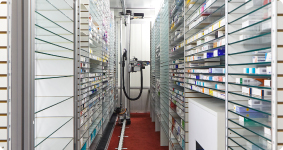Liz Kay, clinical director of medicines management and pharmacy services at Leeds Teaching Hospitals NHS Trust, discusses the introduction of new technology aimed at speeding up the dispensing of controlled drugs from a central hospital pharmacy
All organisations are required to have governance arrangements in place to ensure the safe storage, management and use of controlled drugs in line with the Misuse of Drugs Act and the Controlled Drugs Regulations 2013.
New technology is helping pharmacies to manage controlled drugs safer and faster, making a real difference to patients on controlled medication
Assurance in adhering to the legal requirements has been a challenge for accountable officers in hospitals over the years, with the processes involved in the safe dispensing of controlled drugs often being time consuming for pharmacy staff and potentially frustrating for patients waiting for their medicines to be supplied.
Now, new technology is helping pharmacies to manage controlled drugs safer and faster, making a real difference to patients on controlled medication.
The technology streamlines processes, replaces manual systems and improves the speed and efficiency of controlled drug management, enabling compliance with the legislation.
Assurance in adhering to the legal requirements has been a challenge for accountable officers in hospitals over the years, with the processes often being time consuming for pharmacy staff and potentially frustrating for patients
At St James’ University Hospital, we issue 2,000 controlled drug items every month and we count the stock daily.

The technology streamlines processes, replaces manual systems and improves the speed and efficiency of controlled drug management
Approximately 2,500 packs of controlled drugs are stocked within the pharmacy department, which have a total value of £15,000.
On reviewing our processes, we found that every day staff were spending three hours, almost half of their shift, making records in controlled drugs’ registers. In addition, the dispensing process itself was time consuming, with nine steps involved for the supply of each individual controlled drug.
We recognised that these administration tasks, undertaken by our experienced team, represented time taken away from patient-facing activities – the central value of our profession.
Leeds Teaching Hospitals NHS Trust was looking for a solution that would automate the storage and supply of medicines within wards and departments and significantly improve the efficiency, security and transparency of medicines management throughout the organisation.
I believe that innovation through better technology will improve our processes and will bring better and safer patient care
I believe that innovation through better technology will improve our processes and will bring better and safer patient care. This technology will help us in pharmacy deliver our goal - the right drug, for the right patient, at the right time.
Healthcare can be seen to be frustratingly late to the digital party in comparison to other industries. Yet, when the significant increase in workload occurring in the NHS is considered, and the challenges experienced within secondary care, it is essential we embrace new technology to help deliver more-efficient services.
Improved efficiency releases time for patient care and creates financial benefits for the health service as a whole.

Liz Kay
Technological change can improve patient safety, which must be at the top of every hospital’s agenda, and especially so when it comes to medication delivery and adherence.
The introduction of the Omnicell cabinet at St James’ University Hospital has resulted in a significant number of benefits.
These include a now-paperless process for the supply of controlled drugs from the pharmacy, and this has halved the time taken in dispensing and accurately checking.
The supply of one controlled drug item has reduced from 6.5 minutes to just three minutes, as well as creating a more-lean dispensing process, reducing from the nine previous steps to six.
When the significant increase in workload occurring in the NHS is considered, and the challenges experienced within secondary care, it is essential we embrace new technology to help deliver more-efficient services
Since installing Omnicell, the trust has made a cost saving of £29,000 in staff time as a result of no longer requiring one member of staff who has been redeployed to a vacant post.
Paul O’Hanlon, managing director at Omnicell UK and Ireland, said: The same Omnicell controlled drugs solution used at Aintree Hospital in Liverpool was highlighted within the recent CQC’s Annual Report (July 2016) for best practice.
“The nurse creates an order from the electronic prescribing system and this order passes electronically through pharmacy stock control and into the controlled drug register/Omnicell.
“Safeguards are in place to ensure that only authorised nurses can place orders and that orders are correct.
“There is also a robust audit process to allow ward managers to know who in their teams is placing orders and how frequently.”
“The system not only showcases a simple and efficient process for administering the controlled drugs, but a safe and secure home for the drugs.
At Aintree this revolutionary new system means controlled medication is now stored in automated cabinets which fully integrate with EMIS and JAC.
The technician enters the ward order into JAC. Omnicell then collects the information and presents it on the cabinet screen.
The technician then logs into the cabinet using secure fingerprint recognition, sees the ward name, selects the ward, and then selects their CDs off a prepopulated list. They then simply follow the guiding lights and confirm the balance. The transaction is complete and the risk of any medication error is dramatically reduced.
From the perspective of pharmacy teams and nurses working or considering a career in care, the good news is that the digitalisation of some services offers unparalleled opportunities to divert tedious administration time, back into face-to-face patient care
Using the cabinets allows medication to be administered in a much-simpler and safer process, meaning that staff can dispense controlled drugs confidently and accurately.
The cabinets are fingerprint sensitive, so only registered staff can dispense the drugs. This also has improved the audit trail as the electronic register is date and time stamped and allows staff to identify and drill down into the detail of historical transactions, providing more detail that the paper register did, and complying with wider Department of Health initiatives.
From the perspective of pharmacy teams and nurses working or considering a career in care, the good news is that the digitalisation of some services offers unparalleled opportunities to divert tedious administration time, back into face-to-face patient care.
Technology is helping to deliver a 21st-century National Health Service.





